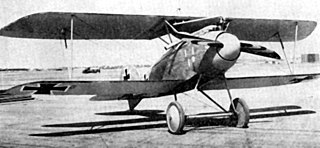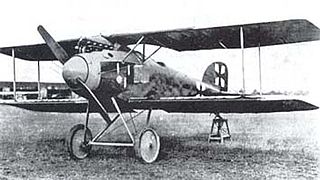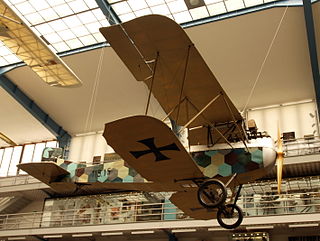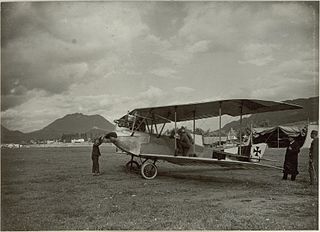
The Albatros D.III was a biplane fighter aircraft used by the Imperial German Army Air Service (Luftstreitkräfte) during World War I. A modified licence model was built by Oeffag for the Austro-Hungarian Air Service (Luftfahrtruppen). The D.III was flown by many top German aces, including Wilhelm Frankl, Erich Löwenhardt, Manfred von Richthofen, Karl Emil Schäfer, Ernst Udet, and Kurt Wolff, and Austro-Hungarian ones, like Godwin von Brumowski. It was the preeminent fighter during the period of German aerial dominance known as "Bloody April" 1917.

The Albatros D.II was a German fighter aircraft used during World War I. After a successful combat career in the early Jagdstaffeln, it was gradually superseded by the Albatros D.III.

The Aviatik B.I is a German two-seat reconnaissance biplane designed and built by the Automobil und Aviatik AG company, who until then had produced copies of French designs.
Automobil und Aviatik AG was a German aircraft manufacturer during World War I. The company was established at Mülhausen in 1909 and soon became one of the country's leading producers of aircraft. It relocated to Freiburg in 1914 and to Leipzig in 1916 and established a subsidiary in Vienna as Österreichisch-Ungarische Flugzeugfabrik Aviatik. During the war, the company became best known for its reconnaissance aircraft, the B.I and B.II, although the Austro-Hungarian subsidiary also produced a number of its own designs, including fighters such as the D.I.

The Austro-Daimler 6 was a series of Austrian six-cylinder water-cooled inline SOHC aero engines first produced in 1910 by the Austro-Daimler company.

The Hansa-Brandenburg C.I, also known as Type LDD, was a 2-seater armed single-engine reconnaissance biplane designed by Ernst Heinkel, who worked at that time for the parent company in Germany. The C.I had similarities with the earlier B.I, including inward-sloping interplane bracing struts. Like other early-war Austro-Hungarian reconnaissance aircraft, such as C-types of Lloyd or Lohner, the Type LDD had a communal cockpit for its crew.

The Hansa-Brandenburg D.I, also known as the KD was a German fighter aircraft of World War I. Despite poor handling characteristics it was put into service by Austria-Hungary, where some aircraft served until the end of the war.

The Lohner L was a reconnaissance flying boat produced in Austria-Hungary during World War I. It was a two-bay biplane of typical configuration for the flying boats of the day, with its pusher engine mounted on struts in the interplane gap. The pilot and observer sat side by side in an open cockpit, and both the upper and lower sets of wings featured sweepback.
The Aviatik (Berg) D.II, the prototypes of which were known as Aviatik 30.22 and Aviatik 30.38, was an Austro-Hungarian fighter plane prototype towards the end of the First World War.
UFAG, was an aircraft manufacturer formed by Freiherr Karl von Škoda in Budapest during World War I. It built aircraft of their own design as well as underlicence to Lohner and Hansa-Brandenburg. Aircraft produced by UFAG were allocated 60 series serial numbers for experimental and prototype aircraft and 61 to 69 for production aircraft.

The Knoller C.II was a reconnaissance aircraft built in Austria-Hungary during World War I for use by the Austro-Hungarian army. It was a conventional biplane design with staggered wings, and seated the pilot and observer in tandem in an open cockpit. Like Knoller's preceding C.I design, the upper wing was swept back, but not as far as it had been on the earlier aircraft. The structure was wooden throughout, with the wings skinned in fabric and the fuselage in plywood. The interplane struts were made of steel and arranged in a warren truss configuration.

The Lloyd C.I was a reconnaissance aircraft produced in Austria-Hungary shortly before and during the First World War, and which formed the basis for a number of other closely related types. It was the Lloyd company's own design, but reflected the DFW designs that Lloyd had previously been building under licence, in particular, in its swept-back, "Pfeil" ("arrow")-style wings. Apart from this feature, it was a conventional biplane design for its day, with staggered wings of unequal span and accommodation for the pilot and observer in tandem, open cockpits. The fuselage was built from welded steel tube, and was covered in fabric. A small load of bombs could be carried internally, to be released by the observer.

The Lloyd C.II and its derivatives, the C.III and C.IV were reconnaissance aircraft produced in Austria-Hungary during the First World War. They were based on the Lloyd company's pre-war C.I design, and like it, were conventional biplanes with swept-back wings.

The Lohner B.I was a military reconnaissance aircraft produced in Austria-Hungary during World War I. As Lohner strove to perfect the design, a variety of increasingly powerful engines were fitted, reflected in a range of military designations from B.II through to B.VI until the definitive B.VII was finally produced. This last version was also produced in an armed variant, designated the C.I.

The Lohner B.II was a military reconnaissance aircraft produced in Austria-Hungary during World War I. It was a development of the pre-war B.I design, incorporating changes requested by the Austro-Hungarian army, but inheriting its predecessor's basic design, including its characteristic swept-back wings.
The Aviatik C.I, the prototypes of which were known as Aviatik 30.14, Aviatik 30.15 and Aviatik 30.16, was an Austro-Hungarian 2-seat reconnaissance aircraft produced from 1917.(Note: the is not part of the designation, but used to disambiguate from the German-built Aviatik aircraft with the same designation.)

The Phönix C.I, given serial numbers in the Phönix 121 range, was an Austro-Hungarian First World War reconnaissance and general-purpose Biplane built by Phönix and Lloyd.
The Ufag D.I was a high-wing monoplane with monocoque fuselage, powered by a Le Rhône(St) engine. Although there is no direct evidence, it is highly likely that the D.I under construction was the Ufag 60.02.

The Lohner Type AA were a series of prototype fighters built during World War I. The program would eventually be cancelled due to inherent instability concerns of the design.
The Phönix 20.24 was a prototype German fighter plane built in the last months of World War I.














